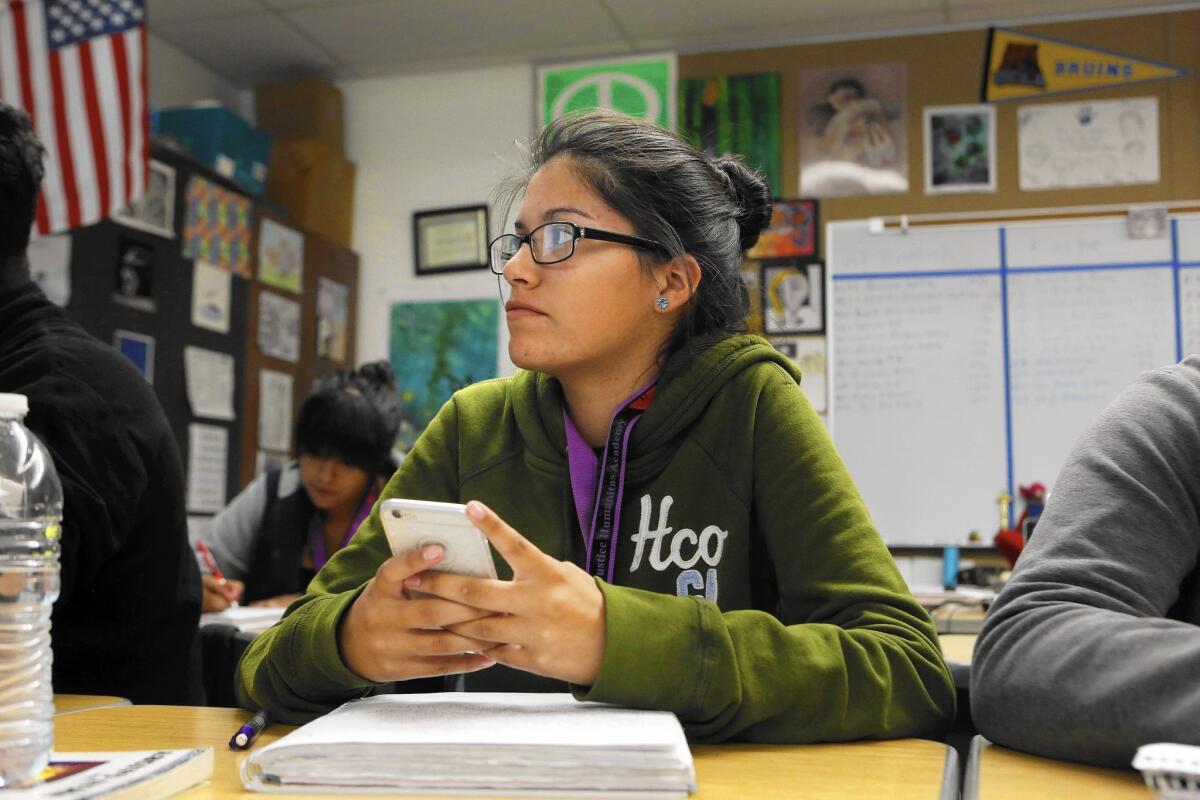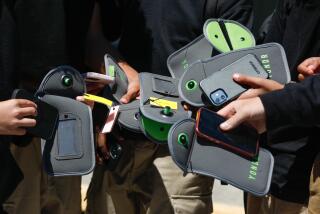Cellphones make a comeback in the classroom, with teachers’ support

- Share via
Priscilla Farinas, an English teacher at Social Justice Humanitas Academy in San Fernando, faced her 31 students recently and made an announcement that seemingly violates official Los Angeles Unified policy.
“This is the one and only time I will have you take out your cellphones,” she said, instructing the students to share their definitions of “privilege” via text message as part of a lesson on “The Great Gatsby.”
Students immediately grabbed their mobile devices. Their texts populated a screen in the front of the classroom. Every student appeared focused on their schoolwork.
Farinas wanted to flip the script: Rather than reprimanding her students for using their phones, she wanted to put them to work as a learning tool. She is among a growing number of teachers who are instructing students to use their phones to conduct research, listen to music, calculate math problems or photograph assignments.
“We’re trying to keep you engaged,” Farinas said. “This is part of a larger lesson: ‘There’s a time and a place to use the cellphone.’”
As cellphones have become ubiquitous in schools, it has become increasingly more difficult for administrators to manage their use. In a dramatic incident recently recorded on a cellphone, a South Carolina sheriff’s deputy pulled a student out of her chair after she allegedly refused to hand over her phone.
In the Los Angeles Unified School District, an official policy mandates confiscating phones used inappropriately in class; students can have their devices if they are off. But schools enforce that rule unevenly. Many teachers take alternative discipline approaches such as placing phones in paper bags on desks, turning a blind eye, and simply asking students to put them away.
Los Angeles school board member Monica Ratliff, who led a committee that probed the district’s ill-fated iPads plan, said that teachers should have some autonomy in how to manage technology use. “I don’t think it’s wise to come up with a one-size-fits-all approach,” she said.
Ratliff also said it is futile to think students will not use phones in class, and uniformly banning them during class is the wrong approach.
Students often use phones in classrooms — and that can be good, Ratliff said. She believes the LAUSD policy needs to be updated to include classroom usage guidelines because it is not “reflective of what’s going on at the schools.”
At Humanitas Academy, administrators say they rarely deal with phone-related discipline problems. As a LAUSD pilot school, teachers are given more autonomy. This extends to cellphones.
“You can have your cellphone, but it has to be used appropriately,” said principal Jose Luis Navarro. “It’s this paradigm shift. You have it, and we trust you will handle it appropriately.”
Erick Vega, 16, noticed a different approach at Humanitas than at his middle school. “They would not trust us to use our phones,” he said. So when he would take out his phone “to take a picture of a homework assignment or take notes, they would expect we were looking at social media or games.”
Vega’s family doesn’t have a computer at home, and his cellphone service was shut off a few months ago, but he uses his mobile device to read, do Google Classroom exercises and access apps like Remind that his teachers use to communicate with students. That trust, he said, creates a feeling of responsibility to use his phone appropriately.
Nationwide, most school districts are reversing their bans on student mobile devices, said Liz Kolb, an assistant professor in the School of Education at the University of Michigan. Districts have found that banning cellphones fails because students will always find ways to bring them in — and because many teachers think phones have some educational value.
An added benefit, said Kolb, is that allowing students to bring in devices is often a more affordable option to schools than providing one for each student. In March, the New York City Department of Education revoked its stringent ban and allowed schools more autonomy. “Lifting the cellphone ban is about common sense,” Schools Chancellor Carmen Fariña said at the time.
At Humanitas, which does not provide each student a laptop or tablet, personal devices help students stay connected to the classroom. Despite the school’s impoverished student body — 94% are classified as socioeconomically disadvantaged — almost every student has a mobile device in Farinas’ class. When a student doesn’t have one Farinas, a second-year teacher, lends hers for the assignment.
Yet the cellphone distraction never completely disappears. Even before Farinas asked her students to grab their phones, many already had a device out on their desks. Some were using them for classroom purposes: One had it ready in case she wanted to photograph an assignment; another to show she had emailed her homework. But a couple others used theirs for less relevant purposes: A boy sketched a design to make his phone cover unique, and a girl quickly slid her phone out of her bag to check the time.
Alexander Tin, a 17-year-old Humanitas senior, concedes that like almost any other student, there are moments when his mind wanders and he reaches for his phone.
“Either because my attention is not fully on what we’re learning or because we’re getting so much information at once and we need a break,” he said.
He feels there is no turning back. “It’s obvious phones are an essential,” he said. Not allowing them in class is “just going to make students less informed.”
Twitter: @dhgerson
More to Read
Sign up for Essential California
The most important California stories and recommendations in your inbox every morning.
You may occasionally receive promotional content from the Los Angeles Times.











